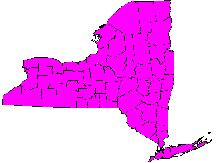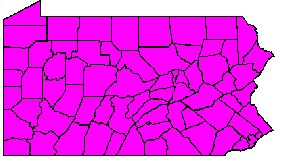Redback Salamanders
Leadback (top) and Redback (bottom)
Plethodon cinereus
Chemung County, NY
Identification- 2.5-4.5" (6.5-11.5 cm) This common salamander
is found in two forms- the redback and
the leadback form. (The Salamanders in
the photos are from Tioga County, NY.) Both forms have a base color
of dark gray with numerous light spots and a stomach mottled in equal concentrations
of gray and white creating a "salt and pepper" effect. The redback phase
has a straight-edged red stripe along the back, narrowing at the tail.
The leadback phase lacks this stripe and the back is black with small white
or brassy flecks. Occasionally tan-striped specimens are found as are all
red erythristic forms. Costal grooves 17-22 (usually 19).
Similar Species- Valley and Ridge Salamanders
and Ravine Salamanders are similar to the leadback phase, but the stomach
of the Valley and Ridge Salamander is dark with a small amount of white
mottling, throat white. Ravine Salamanders are also similar, but the belly
is uniformly dark.
Range- Redback Salamanders are common in appropriate habitat
throughout both NY and PA.
 |
 |
Habitat- Cool, moist forests. Especially common in mixed or deciduous forests near streams, but is also found in coniferous forests. Individuals may be found in unlikely habitats nearing those preferred.
Reproduction- Mates fall and spring. Courtship involves a tail-straddle walk like other lungless salamanders. Males can be distinguished from females by the male's slightly smaller size, more rounded head, and light colored vent. Individual females reproduce every other year. In June or July the female digs a depression beneath some sort of cover. She then lays a clutch of 6-12 eggs deposited in a grape-like cluster attached to the underside of the cover object by an elongated stalk. Females tend the eggs, which hatch 2-3 months later. There is no larval stage and the hatchling are miniature versions of the adults. Maturity is reached in 2-3 years.
Redback Salamander
Plethodon cinereus
Bradford County, PA
General Characteristics-
The Redback Salamander is the most abundant salamander
in our range. They are commonly seen by turning logs, stones, and other
cover in their woodland habitat. In many populations the two color forms
occur in approximately equal numbers, but in others one form predominates.
In general, striped morphs predominate at high elevations and unstriped
forms predominate at low elevations. The reason for this is unknown. The
rare erythristic morph is thought to be involved in a Batesian mimicry
complex with red efts. Birds who have fed on the
toxic efts may learn to avoid the similarly colored erythristic Redback
Salamander. Much of the Redback Salamander's life is spent underground.
Studies have shown that those individuals encountered at the surface are
a significantly small percentage of the overall population. In fact, Redback
Salamanders are thought to be the most abundant vertebrate in the woodland
biome. Redback Salamanders feed mainly on termites, springtails, and other
small invertebrates. Erythristic forms are encountered sporadically throughout
the range covered.